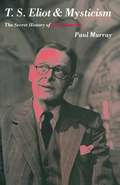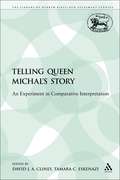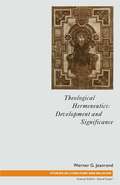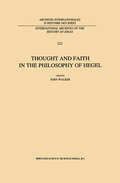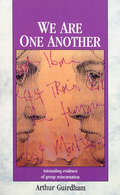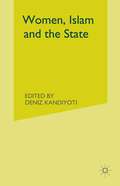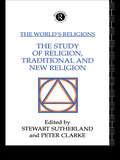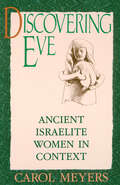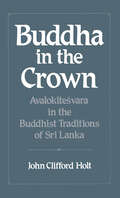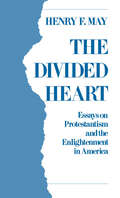- Table View
- List View
Symbolic Houses in Judaism: How Objects and Metaphors Construct Hybrid Places of Belonging (Ashgate Studies in Architecture)
by Mimi Levy LipisInvestigating Jewish spatial practices by exploring the symbol of the house in Judaism, this book examines two groups of houses: ritual objects based on the iconology of the house (ritual houses) and house metaphors (the text, community and the covenant with god as house). This unique pairing is explored as place-making tools which exist in a constant state of tension between diaspora and belonging. Containing many photographs of historical and contemporary artefacts from Europe, Israel and the United States, this book maps out the intersection of architecture, Jewish studies, cultural and gender studies and opens up the discussion of distinctly Jewish objects and metaphors to discourses taking place outside explicitly Jewish contexts.
T.S.Eliot and Mysticism: The Secret History of 'Four Quartets'
by Paul Murray'At last, we have a study that tackles these questions, and does so with a wealth of learning, a poet's sensibility and a thorough theological literacy...Murray has given us a superb study.' Rowan Williams, Doctrine and Life 'His point of view is always that of someone practised in meditation, and his book is in consequence one of the half-dozen really valuable guides to Eliot's poetry.' Stephen Medcalf, Times Literary Supplement The story of the composition of Four Quartets, in relation to mysticism, constitutes one of the most interesting pages in modern literary history. T.S. Eliot drew his inspiration not only from the literature of orthodox Christian mysticism and from a variety of Hindu and Buddhist sources, but also from the literature of the occult, and from several unexpected and so far unacknowledged sources such as the 'mystical' symbolism of Shakespeare's later plays and the visionary poetry of Rudyard Kipling. But the primary concern of this study is not with sources as such, nor with an area somewhere behind the work, but rather with that point in Four Quartets where Eliot's own mystical attitude and his poetry unite and intersect.
Telling Queen Michal's Story: An Experiment in Comparative Interpretation (The Library of Hebrew Bible/Old Testament Studies)
by David J. Clines Tamara C. EskenaziThis book, an anthology of previously published writing about Michal together with some new and original essays, is something of an experiment. Its purpose is to provide reders with raw materials for developing their own reading of the Michal story. It does not offer a unified portrait of this biblical character, but rather invites readers to form their own assessment interactively with these readings of the Michal story. At the same time, this book presents some systematic guidance for coping with these divergent interpretations of the complex and tantalizing figure of Michal.
Theological Hermeneutics: Development and Significance (Library of Philosophy and Religion)
by Werner G. JeanrondAn introduction to the history and scope of interpretation theory in theology. It discusses hermeneutical consciousness in Christian thinking from the time of the Church Fathers up to today.
Thought and Faith in the Philosophy of Hegel (International Archives of the History of Ideas Archives internationales d'histoire des idées #121)
by JohnWalkerThe purpose of this collection of papers is to introduce English speaking philosophers and theologians to something of the variety of the contemporary debate about the religious relevance of Hegel's thought. It is published in the hope that it will appeal not only to specialised students of Hegel's Philosophy of Religion but to a wide audience of scholars interested in Hegel's thought as a whole. The volume grew out of the 1987 Oxford conference on Thought and Faith in the Philosophy of Hegel, but has since developed beyond the confines of the original conference programme. The programme of the conference consisted of five major papers on different aspects of Hegel's religious thought and its reception, followed by a somewhat shorter commentary delivered by another scholar in the same field. This basic format has been retained, but a number of the commentaries have been extended or rewritten and an entirely new piece by Kurt Meist has been commissioned for the purpose of this collection. The volume includes studies of the Lectures on the Philosophy of Religion and the Phenomenology, as well as pieces dealing with the theological relevance of Hegel's philosophy of history and Kierkegaard's attack on Hegel. It con cludes with an examination of the relevance of Hegel's doctrine of absolute Spirit to the modern defence of his philosophy as a whole.
A Traditional Quest: Essays in Honour of Louis Jacobs (The Library of Hebrew Bible/Old Testament Studies)
by Dan Cohn-SherbokLouis Jacobs has made a formidable contribution to Jewish scholarship over the last 40 years. In addition he has inspired a generation of students of Judaica as well as members of his own congregation at the New London Synagogue. The contributors to this volume in his honour include a wide range of distinguished scholars. Beginning with Jacob Neusner's essay on the transformation of the Dual Torah in the first four centuries CE, the volume ranges over a variety of topics in the field of Bible, Talmud, history and theology, mirroring the wide range of Louis Jacobs' own interests. In addition, a full bibliography of Louis Jacobs' publications is included.
The Uses of Antiquity: The Scientific Revolution and the Classical Tradition (Studies in History and Philosophy of Science #10)
by StephenGaukrogerThe institutionalization of History and Philosophy of Science as a distinct field of scholarly endeavour began comparatively earl- though not always under that name - in the Australasian region. An initial lecturing appointment was made at the University of Melbourne immediately after the Second World War, in 1946, and other appoint ments followed as the subject underwent an expansion during the 1950s and 1960s similar to that which took place in other parts of the world. Today there are major Departments at the University of Melbourne, the University of New South Wales and the University of W ollongong, and smaller groups active in many other parts of Australia and in New Zealand. 'Australasian Studies in History and Philosophy of Science' aims to provide a distinctive pUblication outlet for Australian and New Zealand scholars working in the general area of history, philosophy and social studies of science. Each volume comprises a group of essays on a connected theme, edited by an Australian or a New Zealander with special expertise in that particular area. Papers address general issues, however, rather than local ones; parochial topics are avoided. Further more, though in each volume a majority of the contributors is from Australia or New Zealand, contributions from elsewhere are by no means ruled out. Quite the reverse, in fact - they are actively encouraged wherever appropriate to the balance of the volume in question.
We Are One Another (Guirdham Ser.)
by Dr Arthur GuirdhamThis book describes how a group of people, who had lived and suffered together in the 13th century, re-assembled in the 20th century in a limited area in the west of England.Independently of each other these people tuned in, with the piercing accuracy of searchlights, to the same tragic events in the Languedoc in the years 1242 to 1244.One of the most remarkable features of the book is the description of sketches made by a child of seven. It is clear that in these she too was remembering the same tragic years.Of this circle of people alive in the 20th century, the author has discovered the mediaeval names and roles of seven of the eight involved.Though born with a highly developed critical faculty the author regards the material revealed to him as unique. He has written this book to record faithfully an astounding experience and to fulfil the obligation laid on him to provide proof, not only of group reincarnation, but of the indestructibility of the human psyche.
Who’s Who of World Religions
by John R. HinnellsIn historical terms, religions do not exist apart from the people who practise them. This is the first collection of biographical studies of figures from religions around the globe and from traditions both ancient and modern. It represents the work of an enormous international team of scholars, and although many entries involve original research, this substantial work of reference is intended to be of use to both the specialist and the general reader. Particular care has been taken to ensure a balance between religions and to include figures from the diverse branches of the different religions. Indexes and an extensive bibliography make it an invaluable working tool.
The Wisdom of the Serpent: The Myths of Death, Rebirth, and Resurrection.
by Joseph Lewis Henderson Maud OakesThe tribal initiation of the shaman, the archetype of the serpent, exemplifies the death of the self and a rebirth into transcendent life. This book traces the images of spiritual initiation in religious rituals and myths of resurrection, poems and epics, cycles of nature, and art and dreaming. It dramatizes the metamorphosis from a common experience of death's inevitability into a transcendent freedom beyond individual limitations. "This is a classic work in analytical psychology that offers crucial insights on the meaning of death symbolism (and its inevitably accompanying rebirth and resurrection symbolism) as part of the great theme of initiation, of which [Henderson] is the world's foremost psychological interpreter. This material is really the next step after the hero myth that Joseph Campbell has made so popular, and provides an understanding of how not to use the hero myth in an inflated way as a psychology of mastery, but as an attainment progressively to be died beyond. [Henderson] is helped by the presence of Maud Oakes, who is a trained anthropologist with exquisite taste in her choice of mythic materials and respect for their original contexts."--John Beebe
The Wisdom of the Serpent: The Myths of Death, Rebirth, and Resurrection. (Mythos: The Princeton/Bollingen Series in World Mythology #136)
by Joseph Lewis Henderson Maud OakesThe tribal initiation of the shaman, the archetype of the serpent, exemplifies the death of the self and a rebirth into transcendent life. This book traces the images of spiritual initiation in religious rituals and myths of resurrection, poems and epics, cycles of nature, and art and dreaming. It dramatizes the metamorphosis from a common experience of death's inevitability into a transcendent freedom beyond individual limitations. "This is a classic work in analytical psychology that offers crucial insights on the meaning of death symbolism (and its inevitably accompanying rebirth and resurrection symbolism) as part of the great theme of initiation, of which [Henderson] is the world's foremost psychological interpreter. This material is really the next step after the hero myth that Joseph Campbell has made so popular, and provides an understanding of how not to use the hero myth in an inflated way as a psychology of mastery, but as an attainment progressively to be died beyond. [Henderson] is helped by the presence of Maud Oakes, who is a trained anthropologist with exquisite taste in her choice of mythic materials and respect for their original contexts."--John Beebe
The Wisdom of the Serpent: The Myths of Death, Rebirth, and Resurrection. (Mythos: The Princeton/Bollingen Series in World Mythology #136)
by Joseph Lewis Henderson Maud OakesThe tribal initiation of the shaman, the archetype of the serpent, exemplifies the death of the self and a rebirth into transcendent life. This book traces the images of spiritual initiation in religious rituals and myths of resurrection, poems and epics, cycles of nature, and art and dreaming. It dramatizes the metamorphosis from a common experience of death's inevitability into a transcendent freedom beyond individual limitations. "This is a classic work in analytical psychology that offers crucial insights on the meaning of death symbolism (and its inevitably accompanying rebirth and resurrection symbolism) as part of the great theme of initiation, of which [Henderson] is the world's foremost psychological interpreter. This material is really the next step after the hero myth that Joseph Campbell has made so popular, and provides an understanding of how not to use the hero myth in an inflated way as a psychology of mastery, but as an attainment progressively to be died beyond. [Henderson] is helped by the presence of Maud Oakes, who is a trained anthropologist with exquisite taste in her choice of mythic materials and respect for their original contexts."--John Beebe
Women, Islam and the State
by Deniz KandiyotiPolitical projects of modern nation-states, the specificities of their nationalist histories and the positioning of Islam vis-a-vis diverse nationalisms are addressed in this volume with respect to their implications and consequences for women through a series of case studies.
The World's Religions: The Study Of Religion, Traditional And New Religion (The\world's Religions Ser.)
by Peter Clarke Stewart SutherlandExamines the `primitive' (traditional) non -mainstream religion and also 20th century sects such as the Moonies and Scientology. Looks at the `nature' of religion - the general philosophical issues. Written by international specialists.
The World's Religions: The Study of Religion, Traditional and New Religion
by Peter Clarke Stewart SutherlandExamines the `primitive' (traditional) non -mainstream religion and also 20th century sects such as the Moonies and Scientology. Looks at the `nature' of religion - the general philosophical issues. Written by international specialists.
Discovering Eve: Ancient Israelite Women in Context
by Carol MeyersThis groundbreaking study looks beyond biblical texts, which have had a powerful influence over our views of women's roles and worth, in order to reconstruct the typical everyday lives of women in ancient Israel. Meyers argues that biblical sources alone do not give a true picture of ancient Israelite women because urban elite males wrote the vast majority of the scriptural texts and the stories of women in the Bible concern exceptional individuals rather than ordinary Israelite women. Analyzing the biblical material in light of recent archaeological discoveries about rural village life in ancient Palestine, Meyers depicts Israelite women not as submissive chattel in an oppressive patriarchy, but rather as strong and significant actors within their families and society.
Buddha in the Crown: Avalokitesvara in the Buddhist Traditions of Sri Lanka
by John Clifford HoltHistorical, anthropological, and philosophical in approach, Buddha in the Crown is a case study in religious and cultural change. It examines the various ways in which Avalokitesvara, the most well known and proliferated bodhisattva of Mahayana Buddhism throughout south, southeast, and east Asia, was assimilated into the transforming religious culture of Sri Lanka, one of the most pluralistic in Asia. Exploring the expressions of the bodhisattva's cult in Sanskrit and Sinhala literature, in iconography, epigraphy, ritual, symbol, and myth, the author develops a provocative thesis regarding the dynamics of religious change. Interdisciplinary in scope, addressing a wide variety of issues relating to Buddhist thought and practice, and providing new and original information on the rich cultural history of Sri Lanka, this book will interest students of Buddhism and South Asia.
Wisdom in Revolt: Metaphorical Theology in the Book of Job (The Library of Hebrew Bible/Old Testament Studies)
by Leo G. PerdueOnce the 'poor relation' of biblical theology, Wisdom is now assuming a central role in the reconstruction of Israelite religion and the formation of scripture. This clear yet sophisticated study brings together creation, anthropology, myth, narrative, metaphor and much else in a comprehensive synthesis representing the fruits of nearly two decades of research by a leading student of Wisdom.
The Divided Heart: Essays on Protestantism and the Enlightenment in America
by Henry F. MayBringing together essays by a leading intellectual and religious historian, The Divided Heart is a collection of recent reflections, sometimes with a considerable autobiographical element, by Henry F. May on the conflict between Protestantism and the Enlightenment that runs throughout the history of American culture. Summarizing May's opinions on recent historiographical arguments, the introduction to The Divided Heart tells of his own development as a historian, major influences upon his thinking, and how his practicing assumptions grew. Covering religion, there are essays on early American history, Jonathan Edwards, Harriet Beecher Stowe, Reinhold Niebuhr, and "reflections on the uneasy relation" between religion and American intellectual history. Relating to the Enlightenment, there are essays on the Constitution and the "Jeffersonian Moment." Suggesting a new and interdisciplinary approach, May's last essay deals with the end of the Enlightenment and the beginning of Romanticism, an area of history with which he has never before dealt.
Catholic Religious Poets: From Southwell to Crawshaw
by Anthony D. CousinsWhile so much has been written about the English Protestant religious poets of the late 16th and earlier 17th centuries, there is relatively little study on the Catholic religious poets. Cousins fills this gap with his critical history of the Catholic religious poets major phase in the English Renaissance. In studying the Catholic religious poets from Southwell to Crashaw, this book focuses on the interplay in their verse between natively English and Counter-Reformation devotional literary traditions. Cousins puts forward particularly two arguments: that most of the more important Catholic poets write verse which expresses a Christ-centred vision of reality; that the divine agape receives almost as much attention in the Catholic poets' verse as does devout eros. In The Catholic Religious Poets Cousins defends the work of the Catholic religious poets arguing that this literary tradition deserves closer examination and higher valuation than it has usually been given.
The Rude Hand of Innovation: Religion and Social Order in Albany, New York 1652-1836 (Religion in America)
by David G. HackettThis path-breaking study analyzes the social and religious transformation of Albany, New York, from the town's colonial origins through industrialization in the early nineteenth century. Rather than see the transformation of traditional societies as a process of modernization, Hackett adopts a broader conception of religion as a cultural system and argues that culture influences social order differently in different historical periods. During most of Albany's colonial period, the Dutch townspeople absorbed British people and customs into their Calvinist way of life. Following the Revolution, large scale immigration, urbanization, and the initial spurt of an industrial economy transformed Albany into a bustling commercial center. At the same time new political and religious ideologies that disagreed among themselves yet together advocated economic growth, democracy, education, and individual rights, challenged and finally replaced Calvinism. Drawing on the resources of sociology, social history, and religion, this study illuminates not only the social history of Albany but also presents a new interpretation of the relationship between religion and social order in American history.
Property and the Family in Biblical Law (The Library of Hebrew Bible/Old Testament Studies)
by Raymond WestbrookBiblical property law was concerned less with the efficient use and transfer of commercial assets than with protecting the rights of the family to the sources of their economic survival. This important collection of essays explores the legal link between property and family in the Bible, whether through the general law of inheritance or through special institutions such as redemption, the levirate and the sabbatical and jubilee years. It brings together the author's existing contributions, previously published in disparate law journals, to which have been added several unpublished studies and a general introduction.
Religion in Psychodynamic Perspective: The Contributions of Paul W. Pruyser
by P. W. PruyserAt his death in 1987, Paul W. Pruyser of the Menninger Foundation was widely recognized as one of America's foremost authorities on the psychology of religion. His book A Dynamic Psychology of Religion set the stage for creative dialogue on the subject. In this volume, two leading practitioners in the field present a compilation of Pruyser's seminal articles, providing an overview of the major themes in Pruyser's thought. Newton Malony and Bernard Spilka evaluate Pruyser's viewpoint and suggest how his position continues to influence the psychology of religion.
King Saul in the Historiography of Judah (The Library of Hebrew Bible/Old Testament Studies)
by Diana Vikander EdelmanA sustained close reading of 1 Samuel 8 to 2 Samuel 1 from the perspective of the intended ancient audience. A conscious effort is made here to read and understand the text 'through the eyes of an ancient Israelite', to the extent that the world-view and idioms of late seventh-century Judah can be reconstructed. The study reveals a coherent, carefully developed narrative of Saul's career as the first king of Israel.
Female Piety in Puritan New England: The Emergence of Religious Humanism (Religion in America)
by Amanda PorterfieldA synthesis of literary critical and historical methods, Porterfield's book combines insightful analysis of Puritan theological writings with detailed examinations of historical records showing the changing patterns of church membership and domestic life. She finds that by conflating marriage as a trope of grace with marriage as a social construct, Puritan ministers invested relationships between husbands and wives with religious meaning. Images of female piety represented the humility that Puritans believed led all Christians to self-control and, ultimately, to love. But while images of female piety were important for men primarily as aids to controlling aggression and ambition, they were primarily attractive to women as aids to exercising indirect influence over men and obtaining public recognition and status.

